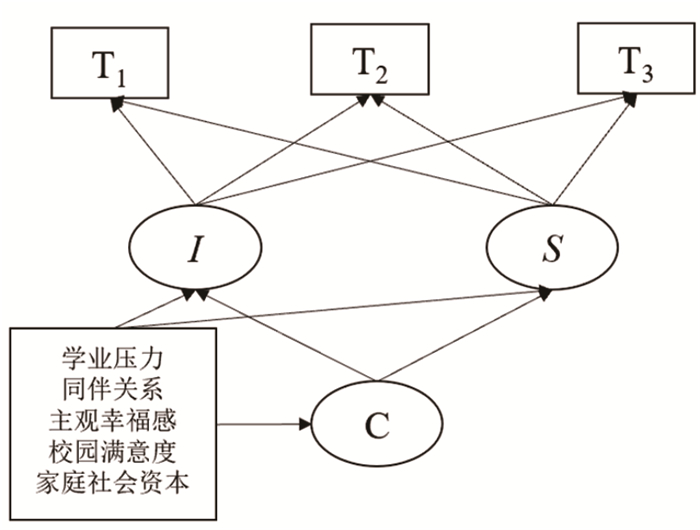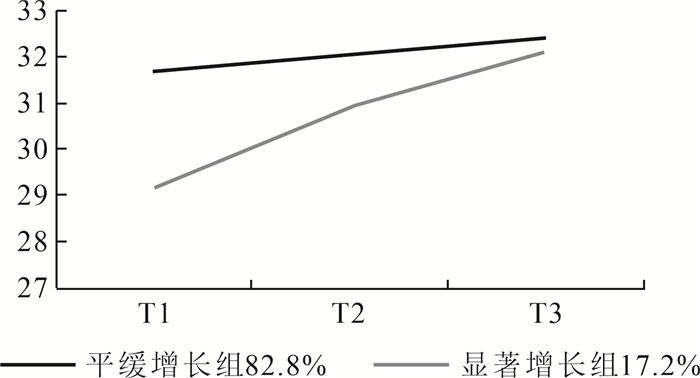Development Trajectory of Adolescent Self-esteem and Cluster Effect Analysis: Based on Growth Mixture Model
-
摘要:
使用中国家庭追踪调查(CFPS)数据,筛选出471名青少年的自尊水平及其他相关数据,探讨青少年自尊发展轨迹及其群组效应。采用增长混合模型(GMM)对三个波次(T1、T2、T3)青少年自尊水平数据进行追踪分析。结果表明:三个波次数据的拟合结果良好,存在两个发展趋势不一致的子群体,分别是平缓增长组和显著增长组;学业压力、同伴关系、主观幸福感和家庭社会资本对青少年群体的自尊发展轨迹具有显著的预测作用;青少年自尊发展轨迹存在性别和城乡的群组效应。青少年自尊发展轨迹受多方面因素影响,且存在群组差异。
Abstract:As one of the criteria to test the mental health of adolescents, researchers in psychology and pedagogy pay more and more attention to the research related to self-esteem level. Most of the previous research paradigms on adolescent self-esteem used cross-sectional studies, without further investigating the characteristics of changes in self-esteem levels over time. The adolescent self-esteem is affected by many factors in the process of development, and the influence of these factors on the development of self-esteem remains to be further explored. To explore the developmental trajectory and cluster effects of adolescent self-esteem. Using data from the China family panel studies (CFPS), 471 adolescents were screened for their self-esteem levels and other related data. The growth mixture model (GMM) was used to track and analyze the self-esteem level data for adolescents in three different bands. Results showed: (1) The fitting results of the three band data were good, with two subgroups with inconsistent development trends, namely the gentle growth group (N=390, 82.8%) and the significant growth group (N=81, 17.2%); (2) According to the results of logistic regression analysis, learning pressure, peer relationships, subjective well-being, and family social capital have a significant predictive effect on the self-esteem development trajectory of adolescent groups; (3) There are gender and urban-rural cluster effect in the developmental trajectory of adolescent self-esteem. The developmental trajectory of adolescent self-esteem is influenced by multiple factors and there are differences in cluster effects.
-
一. 引言
自尊作为衡量青少年心理健康水平的指标之一,受到心理学和教育学研究者的关注,而青少年的自尊水平发展及其影响因素更是这一领域的研究热点。哈特(Harter)认为,小学到初中阶段是个体在学业生涯中面临的第一个转折点,这个时期是探究个体自尊水平稳定性和变化的重要时期[1]。有关青少年心理健康问题所导致的校园危机事件层出不穷,如校园暴力、抑郁和学业压力等。一项针对自尊的元分析研究发现,自尊水平与问题行为、认知(自我效能感和学业成就)、情绪(焦虑)、主观幸福感等因素密切相关[2]。研究表明,过高的学业压力不利于学生自尊的发展[3-4]。达夏·金亮等人针对自尊的影响因素进行了研究,发现同伴关系在自尊与青少年健康促进行为之间具有一定的中介作用,且自尊可以在同伴关系的作用下促进青少年的健康行为[3]。一项针对中国青少年主观幸福观的元分析研究发现,青少年主观幸福感与自尊之间呈中等水平的相关,同时地域与年代两个变量的调节作用显著,自尊在发展过程中会受到学业压力、同伴关系、社会资本的影响,同时也会反过来影响个体的主观幸福感[5]。
美国心理学家勃朗芬布伦纳(Bronfenbrenner)提出了生态系统理论,认为个体的成长与环境密不可分,反对以往心理学研究将研究对象限定在实验室环境中,得出的结论无法适用于更广阔的现实环境[4]。因此,个体心理发展无法摆脱环境因素带来的影响。社会资本是个体心理社会发展、健康和主观幸福感的重要社会决定因素,其可以进一步划分为家庭社会资本和校园社会资本,家庭社会资本体现于父母的职业和收入水平,校园社会资本则体现于学生对学校的满意度。但目前鲜有研究涉及青少年自尊与校园、家庭因素之间的双重关系。
多数研究从横向的角度探究不同因素对青少年自尊的影响[6],也有学者采用纵向范式对青少年的自尊发展轨迹进行研究。例如,使用增长曲线模型对11—21岁青少年群体自尊水平的个体内部变化进行动态追踪研究,发现青少年自尊水平在发展过程中存在巨大差异[7]。另一项研究在此基础上也发现了类似的结果,根据青少年群体发展轨迹特点,将三个子群体分别命名为“稳定高水平组”“稳定低水平组”和“U型组”[8]。青少年群体中有部分子群体的自尊发展轨迹呈U型趋势,该结果与前人研究略有不同。国内一些研究者针对这一特点也进行了相关探索,发现青少年群体的自尊发展轨迹呈U型趋势[9],这与另一篇早期研究结论相类似[10]。此外,有学者应用潜在类别增长模型探究青少年自尊发展的群体内部差异,发现青少年群体在自尊发展上存在三个子群体,分别为高-上升组(70.7%)、中-缓慢下降组(26.7%)和低-快速下降组(2.6%)[11]。
有关青少年自尊发展的现有研究尚存在三个方面的问题。一是现有研究大多为横断研究[5-6],间接考察影响因素对自尊的影响,而并未直接考察自尊的发展轨迹。二是国内现有研究较少从纵向角度探究多个因素对自尊发展的直接影响,因素包括性别、城乡、学业压力、同伴关系、社会资本、主观幸福感等。三是虽有一些研究做过纵向分析,但数据分析时较少考虑群体异质性,多使用潜变量增长曲线模型(Latent Growth Curve Model,LGCM),鲜有研究使用增长混合模型(Growth Mixture Model,GMM)。增长混合模型的优势之一是可以探究群体的异质性,并更好地探索其群组效应。
基于上述研究现状,本研究旨在探讨以下三个问题:其一,中国青少年的自尊发展轨迹呈现何种特点,是否与国内外的相关研究结果保持一致;其二,何种因素会影响青少年的自尊发展轨迹,这些因素能否预测青少年的自尊发展轨迹;其三,基于青少年自尊发展轨迹在群体上存在异质性,协变量和三个不同时间点的自尊水平在性别、城乡上是否存在群组效应。
二. 研究方法
一 研究对象
中国家庭追踪调查(China Family Panel Studies,CFPS)是一项全国性、综合性的社会追踪调查项目。本研究以2010年的调查数据为基线数据(变量),并将在后续(2012年和2014年)追踪调查中加入的个体也纳入考察范围。为确保历年追踪数据的一致性,以及CFPS本身对问卷作答年龄的限制,基线调查的被试年龄被限定在10岁,即2000年出生的个体。2012年的数据除了包含部分2010年的追踪数据外,也纳入了第一次参与调查的12岁青少年群体数据。2014年的数据除了包含部分2010年的追踪数据外,也纳入了第一次参与调查的14岁青少年群体数据。最后纳入参与者共471名,其中,男性240人,女性231人;城镇人口280人,农村人口191人。
二 研究工具
1 自尊量表
采用自尊自评量表(Rosenberg Self-Estee Scale, RSES)对青少年的自尊水平进行测量。RSES由罗森伯格(Rosenberg)编制[12],最初用以评定青少年关于自我价值和自我接纳的总体感受。目前,该量表是心理学界使用最多的自尊测量工具之一,其原始版本由5个正向计分题和5个反向计分题组成,每个问题为5级评分。为保证历次追踪问卷的一致性,最终采用了RSES中的第1、2、3、4、5、6、7、9、10题。对于1、2、4、6、7题(正向计分题),将“十分同意”计5分、“同意”计4分、“既不同意也不反对”计3分、“不同意”计2分、“十分不同意”计1分。对于3、5、9、10题(反向计分题),将“十分同意”计1分、“同意”计2分、“既不同意也不反对”计3分、“不同意”计4分、“十分不同意”计5分。最终总分值越高,自尊程度越高。删改后的RSES在10岁、12岁和14岁群体中的Cronbach's α系数分别为0.795、0.728和0.787。
2 其他工具
中国家庭追踪调查项目的问卷中没有专门测量个体学业压力、同伴关系、主观幸福感、校园满意度、家庭社会资本的题目,因此只能筛选与这些变量相关的题目进行研究。上述变量的数据来源于中国家庭追踪调查的《10—15岁少儿问卷》以及《通用问卷》的R部分和S部分。其他变量测量工具包括以下五部分。
(1) 学业压力。学业压力在少儿问卷中只有1道主观题,即“您觉得自己学业上的压力为哪一级”(KS502)。该题为5级正向评分,没有压力为1分,有很大压力为5分,从1—5进行自评,得分越高即学业压力越大。
(2) 同伴关系。CFPS项目下的青少年自答问卷中有许多关于青少年同伴关系或人际关系的描述。如“在非假期的一个月,你们多久联系一次”(WK417),几乎没有联系计1分,2—3个月1次计2分,每月2—3次计3分,每周2—3次计4分,几乎每天计5分。“你认为你们之间的关系有多好”(WK418)、“你觉得你父母对你最好的朋友的了解有多少”(WK419)、“你认为自己的人缘关系有多好”(WM301)、“你认为你在与人相处方面能打几分”(WM304),以上问题均为5级评分,采用正向评分标准,得分越高说明青少年的同伴关系越好。同伴关系5道题的Cronbach's α系数为0.895。
(3) 主观幸福感。在少儿问卷中,用“你觉得自己有多幸福”(WM302)来测量参与者的主观幸福感。该题为5级正向计分,1表示自我感觉非常不幸福,5表示自我感觉非常幸福,得分越高即主观幸福感越强。
(4) 校园满意度。校园社会资本主要通过学生对学校的满意度来体现,问卷中涉及学校满意度的项目共5个,分别是KS701—KS705。5个项目分别询问了学生对学校、班主任和语文、数学、英语三个科目老师的满意度,均为5级正向计分题。将5个项目的得分相加,以其总分(KS7)表示个体的校园满意度水平。校园满意度5道题的Cronbach's α系数为0.915。
(5) 家庭社会资本。家庭社会资本表示家长对学生的教育投入以及学生自身的经济水平。在少儿问卷中,共2道题涉及家庭经济情况,均可视为连续变量,如“最近非假期你平均每月有多少零花钱”(WK701)、“请问最近的一个月,您平均每周花多少时间参加辅导班”(KR411)。家庭社会资本2道题的Cronbach's α系数为0.692。
三 分析策略
增长混合模型假设群体内部存在异质性,具有不同特质的子群体存在不同的增长轨迹,通过多个不同子群体的增长轨迹的截距和斜率定义不同的潜在类别群体。数据包括三次测量:T1为第一次测量(2010年),共471人; T2为第二次测量(2012年),共407人; T3为第三次测量(2014年),共319人。纳入分析的数据至少包含两次测量数据,缺失数据统一编码为“-999”。数据的建模与分析分别采用Mplus 8.3和SPSS 25软件。由于参与者的自尊水平得分在整体上呈高峰偏态分布,因此对参数进行估计时,采用稳健的极大似然估计法。当存在非随机缺失数据时,Mplus 8.3采用全信息极大似然估计法对缺失数据进行估计。除了探究青少年的自尊发展轨迹外,本研究还进一步探究了各基线变量对青少年自尊发展轨迹的预测作用,即协变量(影响因素)对自尊发展轨迹的影响,包括学业压力、同伴关系、主观幸福感、校园满意度和家庭社会资本,如图 1所示。此外,本研究也进行了后续分析,即分析协变量和三个不同时间点的自尊水平在性别、城乡上的群组效应。
三. 结果分析
一 描述统计结果
各变量的均值、标准差、变量间相关系数结果如表 1所示。
表 1 各变量均值、标准差、变量间相关系数结果M SD T1 T2 T3 KS502 WK417 WK418 WK419 WM301 WM304 WM302 KS7 WK701 自尊(T1) 31.15 3.04 1 自尊(T2) 32.11 3.15 0.20** 1 自尊(T3) 32.45 3.11 -0.15 -0.14 1 学业压力(KS502) 2.66 1.19 -0.02 0.01 0.06 1 同伴关系(WK417) 1.41 0.86 -0.01 0.01 0.03 0.06 1 同伴关系(WK418) 4.44 0.91 0.10* 0.08 0.04 -0.04 -0.14** 1 同伴关系(WK419) 2.86 1.40 -0.02 -0.02 0.07 0.04 0.08 -0.12** 1 同伴关系(WM301) 4.00 0.86 0.19** 0.13* -0.10 -0.06 0.03 0.23** 0.10* 1 同伴关系(WM304) 4.10 0.90 0.16** 0.09 0.05 -0.12* -0.01 0.18** -0.03 0.34** 1 主观幸福感(WM302) 4.34 0.82 0.14** 0.16* 0.03 -0.08 -0.08 0.16** -0.02 0.35** 0.32** 1 校园满意度(KS7) 20.76 3.19 0.04 0.02 0.02 -0.04 0.01 0.09 0.01 0.11** 0.25** 0.20** 1 家庭社会资本(WK701) 1.81 1.21 0.05 -0.01 0.11* 0.04 -0.11* 0.01 -0.06 0.01 0.20** 0.05 0.10* 1 家庭社会资本(KR411) 1.55 1.25 0.10* -0.07 -0.06 0.03 0.05 -0.06 -0.09 -0.01 0.04 0.04 0.04 0.11* 注:*p<0.05, **p<0.01,下同。 由表 1可知,在相关矩阵中,三个波次的自尊水平得分只有第一次(T1)和第二次(T2)的分数存在显著相关,其余波次两两均不相关。第一波次的自尊水平与同伴关系(WK418、WM301、WM304)、主观幸福感(WM302)、家庭社会资本(KR411)存在显著相关;第二波次只与主观幸福感相关;第三波次(T3)只与家庭社会资本相关。学业压力(KS502)与同伴关系(WM304)存在显著相关;主观幸福感与同伴关系、校园满意度(KS7)、家庭社会资本(WK701)存在显著相关;校园满意度和家庭社会资本存在显著相关。
二 增长混合模型拟合结果
将三个时间点(T1、T2、T3)的青少年自尊水平得分作为处理数据,使用增长混合模型分析数据,其拟合指标如表 2所示。
表 2 不同潜在类别数量的GMM各个拟合指标AIC BIC aBIC LL 类别一 6 177.076 6 226.960 6 188.874 -3 076.538 类别二 4 786.293 4 869.390 4 805.913 -2 373.146 类别三 4 799.493 4 874.280 4 817.152 -2 381.746 类别四 4 799.031 4 894.593 4 821.595 -2 376.516 增长混合模型的拟合将通过不断增加潜在类别的数量来确定最优的拟合模型。由表 2可知,当潜在类别数为2时,各项指标的值最小。当继续增加潜在类别数时,各项指标的值都会上升。综合各项拟合指标的表现,本研究将两类别增长混合模型定为最优拟合模型。两个潜在类别的截距与斜率如表 3所示。
表 3 各潜在类别的截距与斜率的均值、标准误类别一:平缓增长组(N=390) 类别二:显著增长组(N=81) M SE t M SE t I 31.594 0.148 212.816*** 29.098 0.326 89.311*** S 0.575 0.148 3.880*** 1.549 0.290 5.346*** 注:***p<0.001, 下同。 由表 3可知,增长混合模型的两个潜在类别的增长轨迹均为上升趋势。其中,类别一(N=390,82.8%)的截距显著(I=31.594,t=212.816,p < 0.001),斜率显著(S=0.575,t=3.880,p < 0.001);类别二(N=81,17.2%)的截距显著(I=29.098,t=89.311,p < 0.001),斜率显著(S=1.549, t=5.346,p < 0.001)。两类别的截距和斜率都显著,表明青少年群体的自尊水平呈显著的增长趋势。从整体上看,类别二的斜率要显著大于类别一,表现出更强的“陡峭性”。综合考虑两个潜在类别的增长轨迹特点,将类别一命名为“平缓增长组”,类别二命名为“显著增长组”,其增长轨迹如图 2所示。
三 logistic回归分析结果
为探究基线变量对青少年自尊发展轨迹的预测作用,以潜在类别为因变量,以基线变量为自变量,包括学业压力、同伴关系、主观幸福感、校园满意度和家庭社会资本,建立logistic回归方程,分析各变量对被试所属潜在类别的预测作用,结果如表 4所示。
表 4 协变量对发展轨迹的预测作用(以平缓增长组作为参照组)β SD df p Exp(B) 学业压力(KS502) 0.295 0.119 1 0.013 1.343 同伴关系(WK417) 0.075 0.164 1 0.647 1.078 同伴关系(WK418) 0.188 0.136 1 0.168 1.207 同伴关系(WK419) 0.196 0.097 1 0.043 1.216 同伴关系(WM301) 0.609 0.156 1 0.001 1.839 同伴关系(WM304) 0.504 0.150 1 0.001 1.656 主观幸福感(WM302) 0.351 0.154 1 0.023 1.420 校园满意度(KS7) 0.148 0.089 1 0.095 1.159 家庭社会资本(WK701) 0.541 0.272 1 0.047 1.718 家庭社会资本(KR411) 0.381 0.239 1 0.107 1.470 由表 4可知,与学业压力相关的KS502(β=0.295,p < 0.05),与同伴关系相关的WK419(β=0.196,p < 0.05)、WM301(β=0.609,p=0.001)和WM304(β=0.504,p=0.001)均显著预测青少年所属潜在类别。其中,以平缓增长组作为参照组,学业压力(KS502)每提高一个单位,参与者被归类到显著增长组的概率提高34.3%;同伴关系(WK419)的“父母对参与者的好友的了解”每增加一个单位,参与者被归类到显著增长组的概率提高21.6%;同伴关系(WM301)的“人际关系”每提高一个单位,参与者被归类到显著增长组的概率提高83.9%;同伴关系(WM304)的“与人相处”每提高一个单位,参与者被归类到显著增长组的概率提高65.6%。同理,主观幸福感(WM302)每提高一个单位,参与者被归类到显著增长组的概率提高42.0%;家庭社会资本(WK701)的“零用钱水平”每提高一个单位,参与者被归类到显著增长组的概率提高71.8%。但校园满意度(KS7)和家庭社会资本(KR411)的“补课时间”均不能显著预测参与者所属潜在类别。
四 群组效应分析
由上述可知,青少年自尊发展轨迹存在群体内部异质性,且可分为两类,即平缓增长组和显著增长组。但这两类是否存在群组效应需要进一步探究。因此,本研究进行了性别和城乡的群组效应分析。以性别和城乡为分组变量,进一步分析协变量和三个不同时间点的自尊水平在性别、城乡上的群组效应。协变量即影响因素,包括学业压力、同伴关系、主观幸福感、校园满意度和家庭社会资本,结果如表 5和表 6所示。
表 5 以性别分组时各变量的差异检验结果总体 平缓增长组 显著增长组 男生 女生 t 男生 女生 t 男生 女生 t 学业压力(KS502) 2.76±1.08 2.58±1.27 1.95 2.80±1.07 2.62±1.28 1.48 2.56±1.17 2.36±1.23 0.77 同伴关系(WK417) 1.39±0.72 1.42±0.97 -1.46 1.41±0.70 1.40±1.00 0.08 1.31±0.80 1.48±0.83 -0.93 同伴关系(WK418) 4.42±0.90 4.45±0.91 -0.64 4.44±0.88 4.53±0.86 -0.99 4.31±1.00 4.10±1.08 0.92 同伴关系(WK419) 2.84±1.47 2.89±1.35 -0.64 2.88±1.43 2.93±1.36 -0.42 2.64±1.53 2.69±1.30 -0.16 同伴关系(WM301) 4.01±0.88 4.00±0.89 0.11 4.16±0.81 4.17±0.81 -0.13 3.28±0.86 3.21±0.84 0.36 同伴关系(WM304) 4.03±0.91 4.18±0.88 -1.78 4.21±0.77 4.40±0.70 -1.87 3.15±1.01 3.12±0.90 0.16 主观幸福感(WM302) 4.30±0.81 4.39±0.86 -1.16 4.50±0.65 4.62±0.58 -2.55* 3.30±0.80 3.31±1.05 -0.10 校园满意度(KS7) 20.46±3.10 21.06±3.25 -2.05* 20.78±3.04 21.51±3.00 -2.39* 18.87±2.97 18.93±3.56 -0.08 家庭社会资本(WK701) 1.78±1.19 1.84±1.23 -0.20 1.86±1.24 1.91±1.28 -0.38 1.38±0.78 1.48±0.89 -0.49 家庭社会资本(KR411) 1.49±1.20 1.60±1.30 -0.83 1.53±1.23 1.60±1.30 -0.54 1.28±1.00 1.60±1.33 -1.19 自尊(T1) 31.16±3.11 31.14±2.97 0.07 30.66±3.05 31.55±2.99 -3.20** 31.26±3.18 31.01±2.97 0.88 自尊(T2) 32.08±3.12 32.14±3.19 -0.21 32.10±3.12 31.89±3.09 0.73 32.04±3.12 32.26±3.44 -0.73 自尊(T3) 32.71±2.90 32.18±3.32 1.84 33.07±2.92 32.08±3.45 3.35*** 32.36±2.92 32.38±3.02 -0.07 表 6 以城乡分组时各变量的差异检验结果总体 平缓增长组 显著增长组 城镇 乡村 t 城镇 乡村 t 城镇 乡村 t 学业压力(KS502) 2.63±1.14 2.69±1.22 -0.46 2.65±1.14 2.75±1.22 -0.86 2.31±1.03 2.49±1.23 -0.49 同伴关系(WK417) 1.43±0.94 1.39±0.80 0.06 1.43±0.93 1.39±0.82 0.40 1.54±1.13 1.37±0.75 0.69 同伴关系(WK418) 4.45±0.90 4.44±0.91 0.07 4.46±0.88 4.51±0.86 -0.55 4.15±1.14 4.21±1.03 -0.16 同伴关系(WK419) 2.70±1.37 2.98±1.41 -2.16* 2.74±1.35 3.04±1.42 -2.13* 2.08±1.50 2.78±1.37 -1.67 同伴关系(WM301) 4.12±0.79 3.39±0.94 2.26* 4.18±0.76 4.15±0.85 0.41 3.23±0.73 3.25±0.87 -0.08 同伴关系(WM304) 4.21±0.78 4.03±0.96 2.11* 4.31±0.70 4.30±0.78 0.09 2.85±0.56 3.19±1.00 -1.21 主观幸福感(WM302) 4.40±0.75 4.30±0.88 1.28 4.49±0.67 4.62±0.56 -2.07* 3.23±0.73 3.32±0.97 -0.33 校园满意度(KS7) 20.93±3.32 20.65±3.09 0.91 21.18±3.18 21.13±2.91 0.17 17.46±3.41 19.18±3.19 -1.76 家庭社会资本(WK701) 1.98±1.35 1.69±1.09 2.59** 2.03±1.37 1.77±1.15 2.00* 1.38±0.87 1.44±0.84 -0.22 家庭社会资本(KR411) 2.05±1.56 1.20±0.82 8.02*** 2.01±1.54 1.19±0.83 6.71*** 2.54±1.91 1.24±0.88 3.96*** 自尊(T1) 31.58±3.07 30.85±2.99 1.79 31.08±3.11 30.05±2.99 3.61*** 31.60±3.13 31.88±3.09 -0.96 自尊(T2) 32.72±3.35 31.72±2.96 1.02 32.02±3.45 31.44±2.96 1.89 32.75±3.47 31.98±3.77 2.24* 自尊(T3) 32.78±2.81 32.72±3.25 0.21 32.08±2.82 32.40±3.26 -1.10 32.80±2.81 32.86±3.21 -0.21 由表 5可知,如果不区分潜在变量(即不考虑群体异质性),那么只有与校园满意度相关的KS7存在显著的组间差异(t=-2.05, p < 0.05),其余变量均不存在显著的组间差异。但以性别分组来考虑群体异质性时,平缓增长组表现出较大的显著性差异,特别是在自尊(T1)和自尊(T3)均出现了显著性差异(t=-3.20, p < 0.01;t=3.35, p < 0.001),表现出较强的群体差异性。若以总体来分析,则容易掩盖群体的异质性差异。
由表 6可知,在以城乡作为分组变量的差异检验中,同伴关系(WK419)、同伴关系(WM301)、同伴关系(WM304)、家庭社会资本(WK701)、家庭社会资本(KR411)在总体上均存在显著差异,但三个不同时间点(T1、T2、T3)的自尊水平在总体上均没有出现显著差异。在进行城乡分组后,自尊(T1)和自尊(T2)均有显著性差异(t=3.61, p < 0.001;t=2.24, p < 0.05),出现了群组效应。因此,对于潜变量子群体的群组效应分析,更能揭示类似性别、城乡这类变量的实质性差异。
四. 讨论
一 青少年自尊发展轨迹
关于青少年群体在自尊发展过程中存在潜在类别群体,本研究结果与已有研究结果存在一定差异[8-9]。在两个潜在类别中,青少年的自尊水平都呈现出显著的线性增长趋势,但趋势较为平缓;显著增长组的基线自尊水平要略低于平缓增长组,但其增长轨迹的上升幅度明显比平缓增长组陡峭。前人研究均报告青少年群体的自尊水平在小学到初中会经历一个显著的下降阶段,但在涉及潜在类别分类的各项研究中,均报告有一个稳定的高自尊水平群体。此外,齐默尔曼(Zimmerman)等人的后续研究以及赫希(Hirsch)和杜波依斯(Dubois)的研究都描述了一个“小幅度上升组”群体,其发展轨迹与本研究的两个类别发展轨迹相类似[13-14]。虽然国内外的研究者都发现了青少年的增长趋势呈U型[8-9],但该类别占总参与者的人数较少,大多数参与者都被归类为稳定的高水平类别或缓慢增长的潜在类别。因此,本研究虽然只定义了两个潜在类别,但是两个类别的增长趋势与前人研究仍保持一致[2, 8]。
按照前人研究对青少年自尊发展轨迹特征的定义[15],本研究的两个潜在类别均具有稳定的小幅度上升趋势。在此基础上,进一步细分高水平自尊群体,发现高水平自尊群体的自尊水平仍缓慢增长,但有一小部分个体的增长速率要略高于其余个体。10—14岁是个体从小学向初中过渡的时期,同时也是童年向少年过渡的时期,自尊在这一阶段的发展处于关键转折期。虽然个体在这一阶段要面临升学考试、越来越重的学业负担、全新的人际关系等一系列挑战,但整体上青少年的自尊依旧保持在稳定的高水平,并缓慢地提高。一方面,随着青少年从童年期向少年期过渡,其自我概念越来越清晰,抽象逻辑思维的发展使得其自我评价更加客观理性,更倾向于对自己做出积极的评价;辩证思维的萌芽使得青少年能够更全面地看待他人评价、内化社会评价。另一方面,学业压力、校园满意度在城乡分组时不存在显著差异,表明虽然学生的家庭经济情况存在差异,但教育质量水平是类似的,且学生的日常生活大多在校园中度过,因此家庭因素对学生的自尊影响相对较弱。另外,主观幸福感总体上不存在显著的城乡差异,说明主观幸福感的高低并不单纯取决于物质生活条件的好坏,良好的校园环境与教育质量也可以提高学生的主观幸福感。
二 青少年自尊发展轨迹的影响因素
根据logistic回归分析结果,青少年自尊发展轨迹的影响因素包括学业压力、同伴关系、主观幸福感和家庭社会资本。以平缓增长组作为参照组时,学业压力每提高一个单位,参与者被归类到显著增长组的概率相应地提高。两个潜在类别的学业压力并未达到显著差异,但在第一波次和第二波次中,平缓增长组的自尊水平显著大于显著增长组。因此可以推断,学业压力越大的个体,其自尊水平越低,这与前人关于自尊与学业压力呈显著负相关的研究结论相一致[16]。同伴关系水平越高的参与者,更容易被归类到显著增长组,说明良好的同伴关系不仅有利于儿童青少年的自尊发展,而且能够很好地预测自尊发展[17]。良好的同伴关系意味着,个体从周围他人中获得的积极评价越多,对自我的认识也越全面,更有利于自尊发展。较高的主观幸福感意味着,个体可以获得更多的社会支持,更好地排除消极事件带来的不良影响,从而有助于自尊发展[18]。
从数据分析结果可知,主观幸福感越高的个体更倾向于被归类到自尊水平增长较快的显著增长组。回归分析结果表明,参与者家庭社会资本的零用钱额度每提高一个单位,其被归类到显著增长组的概率提高71.8%。然而,家庭社会资本无法由学生自己决定,因此学校与社会应该通过优化学校的教学制度不断减小家庭社会资本对学生自尊水平发展的影响。
三 青少年自尊发展轨迹的群组效应
使用总体数据对性别和城乡进行三个时间点的自尊水平差异分析,各波次的自尊水平均不存在显著差异。然而,在区分群体异质性后,对两个子群体进行性别和城乡检验,发现三个时间点的自尊水平出现显著差异。其原因可能是,对异质性较强的群体做性别和城乡的整体差异分析时,产生了“对冲”效应,即子群体一和子群体二的实际差异被“中和”了。这表明,以往一些研究因未能考虑到群体异质性的影响,直接使用性别和城乡对纵向研究显变量进行检验的做法不一定正确,而本研究的GMM模型很好地解决了该问题。LGCM假设群体同质, 可以看作是当潜在类别为1时GMM的特例[19]。GMM假设群体异质,不仅可以分析个体差异,也可以分析群体差异[20-21]。
上述结果表明,青少年自尊发展过程没有出现性别和城乡的整体差异,但在子群体内部却表现出较大的差异性,这种差异性由群组效应所致。青少年自尊发展轨迹存在性别和城乡的群组效应,不仅体现于三个时间点的自尊水平,也体现于其他协变量,如同伴关系、主观幸福感、校园满意度、家庭社会资本等。良好的同伴关系代表了个体被同龄人接纳的程度、人际交往能力。人是社会性动物,在成长过程中除了在学校接受基础教育外,个体的社会化很大程度上是通过同伴关系来实现的[18]。平缓增长组的主观幸福感存在显著的城乡差异,表明主观幸福感的高低并不单纯取决于物质生活条件的好坏,良好的校园环境与教育质量也可以提高学生的主观幸福感[22]。校园满意度的测量包含学生对学校的满意度、对班主任的满意度以及对语文、数学和英语三科老师的满意度,校园满意度存在显著的性别差异,女生对校园的综合满意度显著高于男生。不同地区的社会经济发达程度可能是导致城乡差异的潜在原因,家庭物质生活水平影响着青少年的生活环境,制约着其接受教育的质量,进而影响心理健康水平[23]。
四 局限与展望
其一,本研究测量参与者自尊水平的量表由罗森伯格于1965年修订,该量表发布的年代较久远,且在实际测量过程中删除了部分题目,因此该量表在本研究中的区分度并不十分理想。其二,本研究的参与者年龄较小,对问卷题目的理解存在一定的困难。其三,本研究追踪的是10岁的参与者分别在12岁和14岁时的自尊发展变化,每次追踪的时间间隔长达两年;且仅对参与者追踪了两次,未能进一步探究14岁以后青少年自尊发展特点。在未来的纵向研究中,希望可以缩短对参与者的追踪年限,并增加追踪次数直至成年。
五. 结论
(1) 三个波次数据的拟合结果良好,存在两个发展趋势不一致的子群体,分别是平缓增长组和显著增长组。
(2) 根据logistic回归分析结果,学业压力、同伴关系、主观幸福感和家庭社会资本对青少年群体的自尊发展轨迹具有显著的预测作用。
(3) 青少年自尊发展轨迹存在性别和城乡的群组效应。当以性别和城乡为分组变量时,三个时间点的自尊水平无显著差异;但区分群体异质性后,出现了性别和城乡的群组效应。
-
表 1 各变量均值、标准差、变量间相关系数结果
M SD T1 T2 T3 KS502 WK417 WK418 WK419 WM301 WM304 WM302 KS7 WK701 自尊(T1) 31.15 3.04 1 自尊(T2) 32.11 3.15 0.20** 1 自尊(T3) 32.45 3.11 -0.15 -0.14 1 学业压力(KS502) 2.66 1.19 -0.02 0.01 0.06 1 同伴关系(WK417) 1.41 0.86 -0.01 0.01 0.03 0.06 1 同伴关系(WK418) 4.44 0.91 0.10* 0.08 0.04 -0.04 -0.14** 1 同伴关系(WK419) 2.86 1.40 -0.02 -0.02 0.07 0.04 0.08 -0.12** 1 同伴关系(WM301) 4.00 0.86 0.19** 0.13* -0.10 -0.06 0.03 0.23** 0.10* 1 同伴关系(WM304) 4.10 0.90 0.16** 0.09 0.05 -0.12* -0.01 0.18** -0.03 0.34** 1 主观幸福感(WM302) 4.34 0.82 0.14** 0.16* 0.03 -0.08 -0.08 0.16** -0.02 0.35** 0.32** 1 校园满意度(KS7) 20.76 3.19 0.04 0.02 0.02 -0.04 0.01 0.09 0.01 0.11** 0.25** 0.20** 1 家庭社会资本(WK701) 1.81 1.21 0.05 -0.01 0.11* 0.04 -0.11* 0.01 -0.06 0.01 0.20** 0.05 0.10* 1 家庭社会资本(KR411) 1.55 1.25 0.10* -0.07 -0.06 0.03 0.05 -0.06 -0.09 -0.01 0.04 0.04 0.04 0.11* 注:*p<0.05, **p<0.01,下同。 表 2 不同潜在类别数量的GMM各个拟合指标
AIC BIC aBIC LL 类别一 6 177.076 6 226.960 6 188.874 -3 076.538 类别二 4 786.293 4 869.390 4 805.913 -2 373.146 类别三 4 799.493 4 874.280 4 817.152 -2 381.746 类别四 4 799.031 4 894.593 4 821.595 -2 376.516 表 3 各潜在类别的截距与斜率的均值、标准误
类别一:平缓增长组(N=390) 类别二:显著增长组(N=81) M SE t M SE t I 31.594 0.148 212.816*** 29.098 0.326 89.311*** S 0.575 0.148 3.880*** 1.549 0.290 5.346*** 注:***p<0.001, 下同。 表 4 协变量对发展轨迹的预测作用(以平缓增长组作为参照组)
β SD df p Exp(B) 学业压力(KS502) 0.295 0.119 1 0.013 1.343 同伴关系(WK417) 0.075 0.164 1 0.647 1.078 同伴关系(WK418) 0.188 0.136 1 0.168 1.207 同伴关系(WK419) 0.196 0.097 1 0.043 1.216 同伴关系(WM301) 0.609 0.156 1 0.001 1.839 同伴关系(WM304) 0.504 0.150 1 0.001 1.656 主观幸福感(WM302) 0.351 0.154 1 0.023 1.420 校园满意度(KS7) 0.148 0.089 1 0.095 1.159 家庭社会资本(WK701) 0.541 0.272 1 0.047 1.718 家庭社会资本(KR411) 0.381 0.239 1 0.107 1.470 表 5 以性别分组时各变量的差异检验结果
总体 平缓增长组 显著增长组 男生 女生 t 男生 女生 t 男生 女生 t 学业压力(KS502) 2.76±1.08 2.58±1.27 1.95 2.80±1.07 2.62±1.28 1.48 2.56±1.17 2.36±1.23 0.77 同伴关系(WK417) 1.39±0.72 1.42±0.97 -1.46 1.41±0.70 1.40±1.00 0.08 1.31±0.80 1.48±0.83 -0.93 同伴关系(WK418) 4.42±0.90 4.45±0.91 -0.64 4.44±0.88 4.53±0.86 -0.99 4.31±1.00 4.10±1.08 0.92 同伴关系(WK419) 2.84±1.47 2.89±1.35 -0.64 2.88±1.43 2.93±1.36 -0.42 2.64±1.53 2.69±1.30 -0.16 同伴关系(WM301) 4.01±0.88 4.00±0.89 0.11 4.16±0.81 4.17±0.81 -0.13 3.28±0.86 3.21±0.84 0.36 同伴关系(WM304) 4.03±0.91 4.18±0.88 -1.78 4.21±0.77 4.40±0.70 -1.87 3.15±1.01 3.12±0.90 0.16 主观幸福感(WM302) 4.30±0.81 4.39±0.86 -1.16 4.50±0.65 4.62±0.58 -2.55* 3.30±0.80 3.31±1.05 -0.10 校园满意度(KS7) 20.46±3.10 21.06±3.25 -2.05* 20.78±3.04 21.51±3.00 -2.39* 18.87±2.97 18.93±3.56 -0.08 家庭社会资本(WK701) 1.78±1.19 1.84±1.23 -0.20 1.86±1.24 1.91±1.28 -0.38 1.38±0.78 1.48±0.89 -0.49 家庭社会资本(KR411) 1.49±1.20 1.60±1.30 -0.83 1.53±1.23 1.60±1.30 -0.54 1.28±1.00 1.60±1.33 -1.19 自尊(T1) 31.16±3.11 31.14±2.97 0.07 30.66±3.05 31.55±2.99 -3.20** 31.26±3.18 31.01±2.97 0.88 自尊(T2) 32.08±3.12 32.14±3.19 -0.21 32.10±3.12 31.89±3.09 0.73 32.04±3.12 32.26±3.44 -0.73 自尊(T3) 32.71±2.90 32.18±3.32 1.84 33.07±2.92 32.08±3.45 3.35*** 32.36±2.92 32.38±3.02 -0.07 表 6 以城乡分组时各变量的差异检验结果
总体 平缓增长组 显著增长组 城镇 乡村 t 城镇 乡村 t 城镇 乡村 t 学业压力(KS502) 2.63±1.14 2.69±1.22 -0.46 2.65±1.14 2.75±1.22 -0.86 2.31±1.03 2.49±1.23 -0.49 同伴关系(WK417) 1.43±0.94 1.39±0.80 0.06 1.43±0.93 1.39±0.82 0.40 1.54±1.13 1.37±0.75 0.69 同伴关系(WK418) 4.45±0.90 4.44±0.91 0.07 4.46±0.88 4.51±0.86 -0.55 4.15±1.14 4.21±1.03 -0.16 同伴关系(WK419) 2.70±1.37 2.98±1.41 -2.16* 2.74±1.35 3.04±1.42 -2.13* 2.08±1.50 2.78±1.37 -1.67 同伴关系(WM301) 4.12±0.79 3.39±0.94 2.26* 4.18±0.76 4.15±0.85 0.41 3.23±0.73 3.25±0.87 -0.08 同伴关系(WM304) 4.21±0.78 4.03±0.96 2.11* 4.31±0.70 4.30±0.78 0.09 2.85±0.56 3.19±1.00 -1.21 主观幸福感(WM302) 4.40±0.75 4.30±0.88 1.28 4.49±0.67 4.62±0.56 -2.07* 3.23±0.73 3.32±0.97 -0.33 校园满意度(KS7) 20.93±3.32 20.65±3.09 0.91 21.18±3.18 21.13±2.91 0.17 17.46±3.41 19.18±3.19 -1.76 家庭社会资本(WK701) 1.98±1.35 1.69±1.09 2.59** 2.03±1.37 1.77±1.15 2.00* 1.38±0.87 1.44±0.84 -0.22 家庭社会资本(KR411) 2.05±1.56 1.20±0.82 8.02*** 2.01±1.54 1.19±0.83 6.71*** 2.54±1.91 1.24±0.88 3.96*** 自尊(T1) 31.58±3.07 30.85±2.99 1.79 31.08±3.11 30.05±2.99 3.61*** 31.60±3.13 31.88±3.09 -0.96 自尊(T2) 32.72±3.35 31.72±2.96 1.02 32.02±3.45 31.44±2.96 1.89 32.75±3.47 31.98±3.77 2.24* 自尊(T3) 32.78±2.81 32.72±3.25 0.21 32.08±2.82 32.40±3.26 -1.10 32.80±2.81 32.86±3.21 -0.21 -
[1] HARTER S. The construction of the self: a developmental perspective[M]. 1st ed. New York: The Guilford Press, 1999: 40-54.
[2] HUANG C. Mean-Level change in self-esteem from childhood through adulthood: meta-analysis of longitudinal studies[J]. Review of general psychology, 2010, 14(3): 251-260. doi: 10.1037/a0020543
[3] 达夏·金亮, 张澜, 武威. 自尊、同伴关系与青少年健康促进行为的关系[J]. 中国卫生事业管理, 2017, 34(5): 381-383. [4] BRONFENBRENNER U. The ecology of human development[M]. Cambridge MA: Harvard University Press, 1979: 3.
[5] 杨冉, 张艳红. 我国青少年自尊与主观幸福感关系的Meta分析[J]. 长江大学学报(社会科学版), 2019, 42(6): 110-114. [6] 张丽华, 刘方英. 自尊研究的历史与展望[J]. 辽宁师范大学学报(社会科学版), 2015, 38(2): 194-199. [7] BALDWIN S A, HOFFMANN J P. The dynamics of self-esteem: a growth-curve analysis[J]. Journal of youth and adolescence, 2002, 31(2): 101-113. doi: 10.1023/A:1014065825598
[8] BIRKELAND M S, MELKEVIK O, HOLSEN I, et al. Trajectories of global self-esteem development during adolescence[J]. Journal of adolescence, 2012, 35(1): 43-54. doi: 10.1016/j.adolescence.2011.06.006
[9] 潘颖秋. 初中青少年自尊发展趋势及影响因素的追踪分析[J]. 心理学报, 2015, 47 (6): 787-796. [10] HUANG X T, FENG S H, WANG W H. The making of the national norm of adolescent students' self-worth[J]. Psychological science, 2003, 26(2): 194-197.
[11] 王雪. 童年中晚期自尊的发展轨迹: 同伴关系及学业适应的作用[D]. 上海: 上海师范大学, 2017: 26. [12] ROSENBERG M. Society and the adolescent self-image[M]. Princeton NJ: Princeton University Press, 1965: 16-36.
[13] ZIMMERMAN M, COPELAND L, SHOPE J, et al. A longitudinal study of self-esteem: implications for adolescent development[J]. Journal of youth and adolescence, 1997, 26(2): 117-141. doi: 10.1023/A:1024596313925
[14] HIRSCH B, DUBOIS D. Self-esteem in early adolescence-the identification and prediction of contrasting longitudinal trajectories[J]. Journal of youth and adolescence, 1991, 20(1): 53-72. doi: 10.1007/BF01537351
[15] WILL G J, MOUTOUSSIS M. Neurocomputational mechanisms underpinning aberrant social learning in young adults with low self-esteem[J]. Translational psychiatry, 2020, 10(1): 1-14. doi: 10.1038/s41398-019-0665-5
[16] LAIBLE D J, CARLO G, ROESCH S C. Pathways to self-esteem in late adolescence: the role of parent and peer attachment, empathy and social behaviors[J]. Journal of adolescence, 2004, 27(6): 703-716. doi: 10.1016/j.adolescence.2004.05.005
[17] 赖建维, 郑钢, 刘锋. 中学生同伴关系对自尊影响的研究[J]. 中国临床心理学杂志, 2008, 16(1): 74-76. [18] 刘广增, 张大均, 潘彦谷, 等. 中学生心理素质与同伴关系的研究: 自尊的中介作用[J]. 心理科学, 2016, 39(6): 1290-1295. [19] MUTHÉN B O, MUTNÉN L K. Integrating person-centered and variable-centered analyses: growth mixture modeling with latent trajectory classes[J]. Alcoholism-clinical and experimental research, 2000, 24(6): 882-891. doi: 10.1111/j.1530-0277.2000.tb02070.x
[20] BAUER D. Observations on the use of growth mixture models in psychological research[J]. Multivariate behavioral research, 2007, 42(4): 757-786. doi: 10.1080/00273170701710338
[21] MUTHÉN L K, MUTHÉN B O. Mplus user's guide (eighth)[M]. Los Angeles: MUTHÉN MUTHÉN, 2017: 199.
[22] 陈子循, 王晖, 冯映雪, 等. 同伴侵害对留守青少年主观幸福感的影响: 自尊和社会支持的作用[J]. 心理发展与教育, 2020, 36(5): 605-614. [23] 程刚, 牛娟, 余玮, 等. 家庭社会经济地位与中学生心理素质的关系——教育卷入与支出的多重中介作用[J]. 内江师范学院学报, 2021, 36(2): 1-6.







 下载:
下载:

